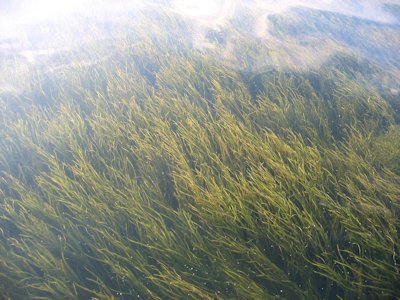
A wild celery bed in the waters of the Chesapeake Bay. Photo courtesy of the Maryland Department of Natural Resources.
ANNAPOLIS (Dec. 19, 2013)—Climate change and human pollution are reducing levels of grasses in the Chesapeake Bay, which are a crucial factor in restoring its health.
Bay grasses not only provide important habitats for wildlife, but experts are learning that healthy beds can be an important line of defense against severe coastal storms.
However, scientists are finding significant declines in the health and diversity of grasses found in the Chesapeake.
According to the Maryland Department of Natural Resources’ Program Chief Lee Karrh, there are at least 17 species of grasses in the bay. Species locations vary throughout the bay, depending on the water’s salt content.
Wild celery and stargrass like to grow in fresher waters of the northern region of the bay, widgeon grass is commonly found in the middle regions, and eelgrass prefers areas of high salt content, such as the lower region near the Virginia state line.
Among the most common bay grasses are eelgrasses, Brazilian and common waterweeds, wild celery and various kinds of pondweeds such as the American, curly and horned pondweeds, according to University of Maryland Atmospheric and Oceanic Science Professor Raghu Murtugudde.
There have been “a lot of changes in what species are most common,” Karrh said. “What’s very concerning is [in the lower part of the bay] we’re losing a lot of eelgrass.” Karrh attributes this change to heat stress in the summers. “2005 and 2010 were very warm summers that impacted the eelgrass more so than other species,” Karrh said, noting that eelgrass is very slow to recover.
Other parts of the bay, especially the middle regions, are experiencing a decline in grass species as well, and a general loss of diversity, Karrh said.
Other factors such as the bay’s salt levels dictate grasses’ growth. Salt levels increase with sea level rise and hurricanes and tropical storms, and drop with extreme rainfall on land.
According to Rich Batiuk, associate director at the U.S. Environmental Protection Agency’s Chesapeake Bay Program office, good water quality is crucial to bay grasses’ health, since polluted or clouded water can block sunlight, and therefore stunt its growth.
Nutrient pollution can pose a big threat to bay grasses, since algae thrive on nitrogen and phosphorus. When these algae overpopulate, algae blooms are created, which cast a layer over the water’s surface that blocks out light, preventing underwater grasses from growing, Batiuk said.
Although nutrients and sedimentation are natural parts of river environments, humans have “modified the landscape extensively by urbanization, agriculture, deforestation, and so on which increases (sediment) loads,” Murtugudde said.
According to Batiuk, runoff from agriculture and residential lawns carries fine, silty material into the bay.
According to Murtugudde, maintaining good water quality in the bay is necessary, because grasses are natural filters, and can reduce harmful algae blooms. “We can hardly overemphasize their role,” he said. “Sub-aquatic vegetation is part of the integrated ecosystem of the bay.” How productive, resilient and biodiverse the bay is all depends on these grasses, he added.
Bay grasses are natural filters against strong storms and nutrient and sediment pollution from land, so they provide excellent habitats for everything from oysters, crabs and small fish to a very large number of microbes, bacteria, insects, and migratory and resident birds, Murtugudde said. “They are critical for maintaining required levels of oxygen for all living species.”
Underwater grasses also help reduce wave strength. “Good grasses will reduce coastal erosion…they have a nice buffering capacity,” Batiuk said. According to Batiuk, areas in Maryland with healthy bay grasses saw less shoreline damage after strong storms in recent years.
As the benefits of bay grasses are becoming clear, their popularity as a coastal protection device is increasing as well. New York City recently decided to restore its Jamaica Bay marshes for coastal defense after Sandy struck. “We don’t need to wait for a disaster to learn these simple lessons,” Murtugudde said, adding that maintaining bay grasses is crucial for the bay’s health.
According to Murtugudde, bay grass revival requires humans to reduce their pollution and runoff, which can be achieved by limiting nutrients used on lawns and agricultural farms, and using permeable paving materials to reduce runoff.
Batiuk said, “People who live in houses can do some simple things” like create rain gardens, place rain barrels under drain-spouts to prevent runoff, and make smart public transportation choices, such as driving low-emission cars and taking public transportation. “This should extend to smart growth concepts and reducing commuter miles on the watershed,” Murtugudde said.
According to Batiuk, public efforts can have “small but incrementally important impacts.”


